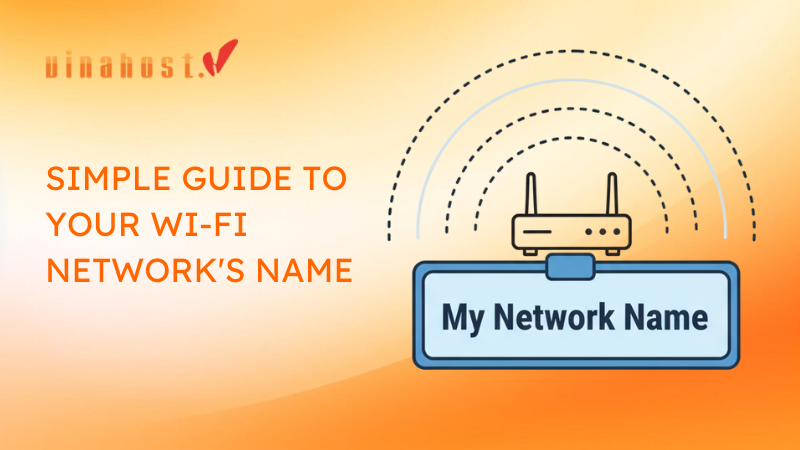What is domain .com? It is one of the most popular domain names currently because it accounts for nearly half of the global domain name market. The .com domain is the gold standard for businesses and individuals who want to make a good impression on customers because it is easy to remember and search for, helping customers easily find your website. This subject will be discussed in a later article by VinaHost.
1. What is domain .com?
A .com domain is a type of top-level domain (TLD) used in the Domain Name System (DNS) of the internet. It is one of the original and most common TLDs, standing for “commercial.”
The .com domain is widely used by businesses, organizations, and individuals for their websites. It is considered highly valuable due to its association with commercial endeavors and its widespread recognition and use.

Also Read: What is Domain & How It Impacts Your Online Presence
2. Understanding the .com Domain Extension
2.1. A Brief History of .com
The history of the formation and development of the .com domain can be divided into three main periods:
Stage 1 (1985-1995)
This stage marked the birth of the .com domain. On March 15, 1985, the world’s first .com domain was registered by Symbolics, Inc., a computer manufacturer. In the following years, the .com domain became increasingly popular, especially among businesses and commercial organizations.
Stage 2 (1995-2005)
This stage marked the explosion of the Internet and the strong development of the .com domain. During these years, the number of registered .com domains increased rapidly, from around 100,000 domains in 1995 to over 100 million domains in 2005.
Stage 3 (2005-present)
This stage marked the emergence of new domains, competing with the .com domain. However, the .com domain continues to be one of the most popular domains in the world, with around 300 million domains registered as of 2023.
2.2. Who Manages .com Domains?
The management of .com domains falls under the responsibility of VeriSign, Inc. VeriSign has been overseeing the operation of the .com domain infrastructure since 1991. As a global provider of domain name registry services and internet infrastructure, VeriSign ensures the stability, secure operation, and scalability of the .com domain.
It manages the registry for .com domain names, facilitating domain registration through various accredited registrars. These registrars are the entities through which individuals and organizations can register a .com domain.
The Internet Corporation for Assigned Names and Numbers (ICANN), a nonprofit organization, oversees the overall internet’s domain name system (DNS) management and policy, including the delegation of top-level domains (TLDs) like .com to registry operators like VeriSign.
3. Benefits of Using a .com Domain
Using a .com domain for your website offers several significant benefits, making it a popular choice for businesses, individuals, and organizations worldwide. Here are some key advantages:
- Global Recognition: The .com TLD is one of the most recognized and trusted domain names globally. It’s synonymous with the internet for many people, lending an air of legitimacy and professionalism to your website.
- Credibility and Trust: A .com domain name can instantly give your site a sense of authority and credibility. Because it’s the most established domain, customers often assume a .com site is more trustworthy.
- Brand Protection: Securing your brand’s .com domain helps protect your brand identity online. It prevents others from registering your brand name under the .com TLD, which could mislead your customers.
- Memorability: .com domains are easy to remember. Given its prevalence and familiarity, users are more likely to recall a .com website address than other TLDs, making it easier for returning visitors to find your site.
- SEO Advantages: While the domain extension itself is not a direct ranking factor, .com domains often perform well in search engine results because they are more likely to be linked to and remembered by users. This can indirectly benefit your site’s SEO.
- Marketability: A .com domain is versatile and suitable for any type of website, whether it’s a personal blog, a corporate website, an online store, or something else. This universality makes it easier to market your site across various mediums and platforms.
- Investment Value: .com domains often have higher resale values than other TLDs. A sought-after .com domain can be a significant investment, retaining or even increasing in value over time.
- Wide Appeal: The .com extension has a broad appeal, making it suitable for international businesses and audiences. It transcends geographic and industry-specific boundaries, unlike some other TLDs that might pigeonhole a site to a particular region or sector.
- Flexibility: You are not limited by geography or industry when registering a .com domain, offering flexibility for businesses that might expand or pivot their operations.
Choosing a .com domain can strategically benefit your online presence, contributing to the perception, reach, and effectiveness of your website. Given its advantages, it’s often the first choice for those looking to establish a strong online identity.

Also Read: The Value of Domain Names: Choosing the Right Domain for Your Website
4. Who Can Register a .com Domain?
Virtually anyone can register a .com domain. There are no geographical or organizational restrictions on who can purchase a .com domain name. This accessibility is one of the reasons why .com is the most popular and widely used top-level domain (TLD) on the internet. Whether you’re an individual, a business, a nonprofit organization, or any other entity, you can register a .com domain as long as the name you want is available and not already taken by someone else.
Here’s a general overview of who can register a .com domain:
- Businesses of all sizes: From small startups to large corporations looking to establish or expand their online presence.
- Individuals: People looking to create a personal blog, portfolio, or personal project site.
- Online stores: E-commerce platforms seeking to market their products globally.
- Educational institutions: Although many use .edu domains, some may opt for a .com domain for certain projects or initiatives.
- Nonprofit organizations: While many nonprofits choose .org, a .com domain is also a popular choice for its wide recognition.
- Freelancers and professionals: Individuals offering services in various fields, such as consulting, writing, design, and more.
To register a .com domain, you would typically go through a domain registrar – a company accredited by ICANN (the Internet Corporation for Assigned Names and Numbers) to sell domain names. You will need to check the availability of your desired domain name through the registrar’s search tool, choose your registration term (usually ranging from 1 to 10 years), and complete the purchase.
After registering, you will also have the option to renew your domain registration before it expires to keep ownership of your .com domain.
Also Read: What is a Subdomain? Exploring the Difference Between Domains & Subdomains
5. Choosing the Right .com Domain Name
Choosing the right .com domain name is a crucial step in establishing a strong online presence for your brand, project, or personal site. A good domain name can enhance brand recognition, improve SEO, and make it easier for visitors to remember and return to your site. Here are some key tips for selecting the right .com domain name:
- Keep It Short and Simple: Aim for a name that is easy to remember, pronounce, and spell. The shorter, the better, as long as it remains meaningful and relevant to your content, product, or service.
- Use Keywords Strategically: Incorporate keywords that describe your business or industry. This can help improve your site’s SEO and make it clearer to potential visitors what your site is about. However, ensure the domain still sounds natural and appealing.
- Avoid Numbers and Hyphens: Numbers and hyphens can be confusing. People might not remember if the number is spelled out or numeric, and hyphens can be forgotten or misplaced. Stick to letters to avoid complications.
- Make It Brandable: Choose a name that reflects your brand’s essence and is unique enough to stand out in the minds of your audience. A brandable name often has a nice ring to it, is memorable, and is open to becoming a brand beyond just a keyword-rich domain.
- Consider Your Target Audience: Think about who your website is for and what kind of domain name would appeal to them. A professional business site might benefit from a more formal name, while a creative project could afford to be more playful or inventive.
- Research Availability: Your desired .com domain might already be taken. Use a domain name registrar’s search tool to check availability. If your first choice isn’t available, consider variations or similar phrases that still capture your brand.
- Look for Close Alternatives: If the exact match domain is taken, look for close alternatives that still convey your brand message. Be creative but clear about your brand or service.
- Think Long-Term: Choose a domain name that you can grow with. Changing a domain name later can be costly in terms of branding and SEO. Think about where you see your project or company in the future and pick a name that aligns with those goals.
- Check for Trademarks: To avoid legal issues, check if your domain name or any part of it is trademarked. You can search through online trademark databases or consult with a legal professional.
- Test It Out: Say the domain name out loud to make sure it sounds good and is easy to understand. You can also test it with friends or potential customers to get their feedback.
Selecting the right .com domain name is an essential step in building your online identity. Take your time, consider your options, and choose a name that will serve your brand well in the years to come.

Also Read: What is Transfer Domain? & How to Transfer a Domain?
6. How to Register a .com Domain
6.1. Choosing a Domain Registrar
When selecting a domain registrar to register your .com domain name, consider the following criteria to ensure you make an informed decision:
- Pricing: Compare the registration and renewal prices for .com domains across different registrars. Look out for any hidden fees or additional costs for services like domain privacy protection.
- Features: Check the features offered by the registrar, such as domain management tools, DNS management, email forwarding, WHOIS privacy protection, and domain forwarding. Ensure the registrar provides the necessary features you need to manage your domain effectively.
- Customer Support: Evaluate the quality and availability of customer support provided by the registrar. Look for options such as phone support, email support, live chat, and comprehensive online documentation. Responsive and knowledgeable customer support can be crucial, especially if you encounter technical issues or need assistance with domain management.
- Ease of Use: Consider the usability of the registrar’s website and domain management interface. A user-friendly interface makes it easier to register, manage, and renew your domain without encountering unnecessary complexity.
- Reputation and Reliability: Research the registrar’s reputation and reliability by reading customer reviews, checking online forums, and reviewing the registrar’s uptime and security measures. Choose a registrar with a proven track record of providing reliable service and safeguarding customer data.
- Domain Transfer Policy: Review the registrar’s domain transfer policy to understand the process and any associated fees for transferring your domain to another registrar in the future. Ensure the registrar allows you to transfer your domain easily if you decide to switch providers.
- Additional Services: Consider whether the registrar offers additional services such as web hosting, email hosting, website builder tools, SSL certificates, and security features. While not essential for domain registration, these services can be convenient if you plan to build a website alongside your domain.
- ICANN Accreditation: Verify that the registrar is accredited by ICANN (the Internet Corporation for Assigned Names and Numbers), the organization responsible for managing the domain name system. ICANN accreditation ensures that the registrar adheres to industry standards and regulations.
By considering these criteria, you can select a domain registrar that meets your needs and provides reliable service for registering and managing your .com domain name. Take your time to research and compare different registrars to make an informed decision that aligns with your requirements and budget.
Domain Registration VietNam | VN Domains | Just 22$
6.2. The Registration Process
When registering a domain name online at VinaHost, the process is conveniently carried out through the following steps:
Step 1: Search and check the domain name
Visit the domain name lookup registration page and enter the information about the domain name you want to register. Click on the “Search” button to check the availability of the domain name. If the domain name is not yet in use, you can add it to the cart by clicking “Registration”. You can also register multiple domain names at the same time without any difficulty.
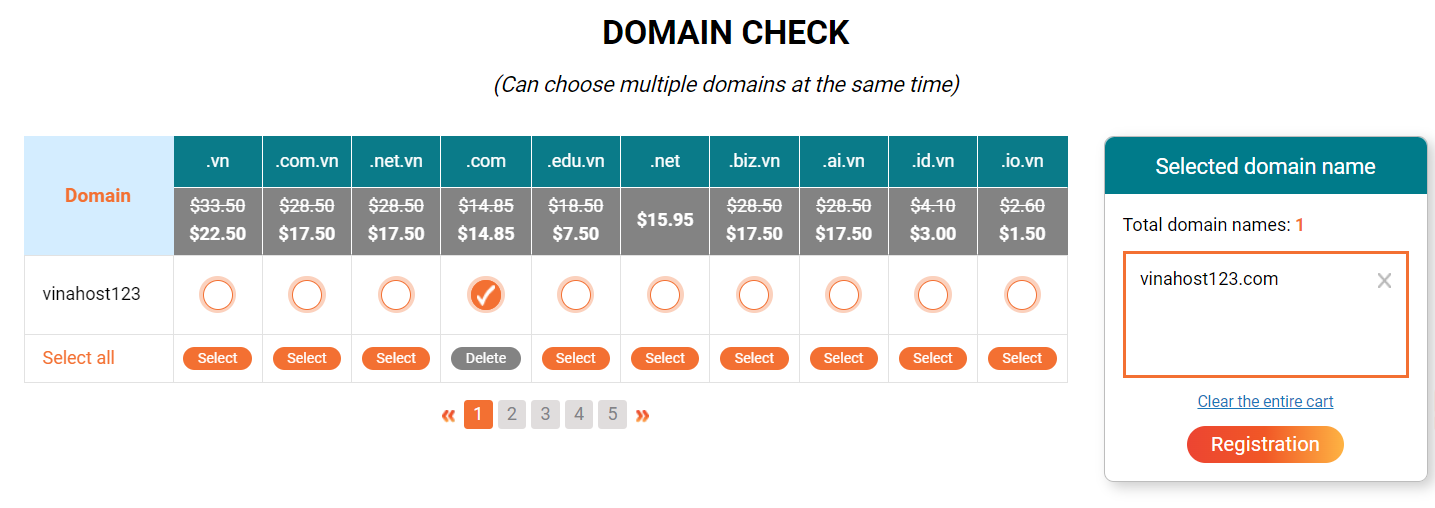
Step 2: Fill in the information
For individuals:
Select the registration type as Individual and enter all the following information:
- Name of the entity
- ID card/ Passport number
- Gender
- Date of birth
- Fill in the address according to the standard, including country, province/city, district, ward/commune, and house number, street name
- Enter the email address
- Enter the phone number
If you are registering multiple domain names for the same entity, you can fill in the information once when registering the first domain name and then choose “Same as…” when registering the subsequent domain names.
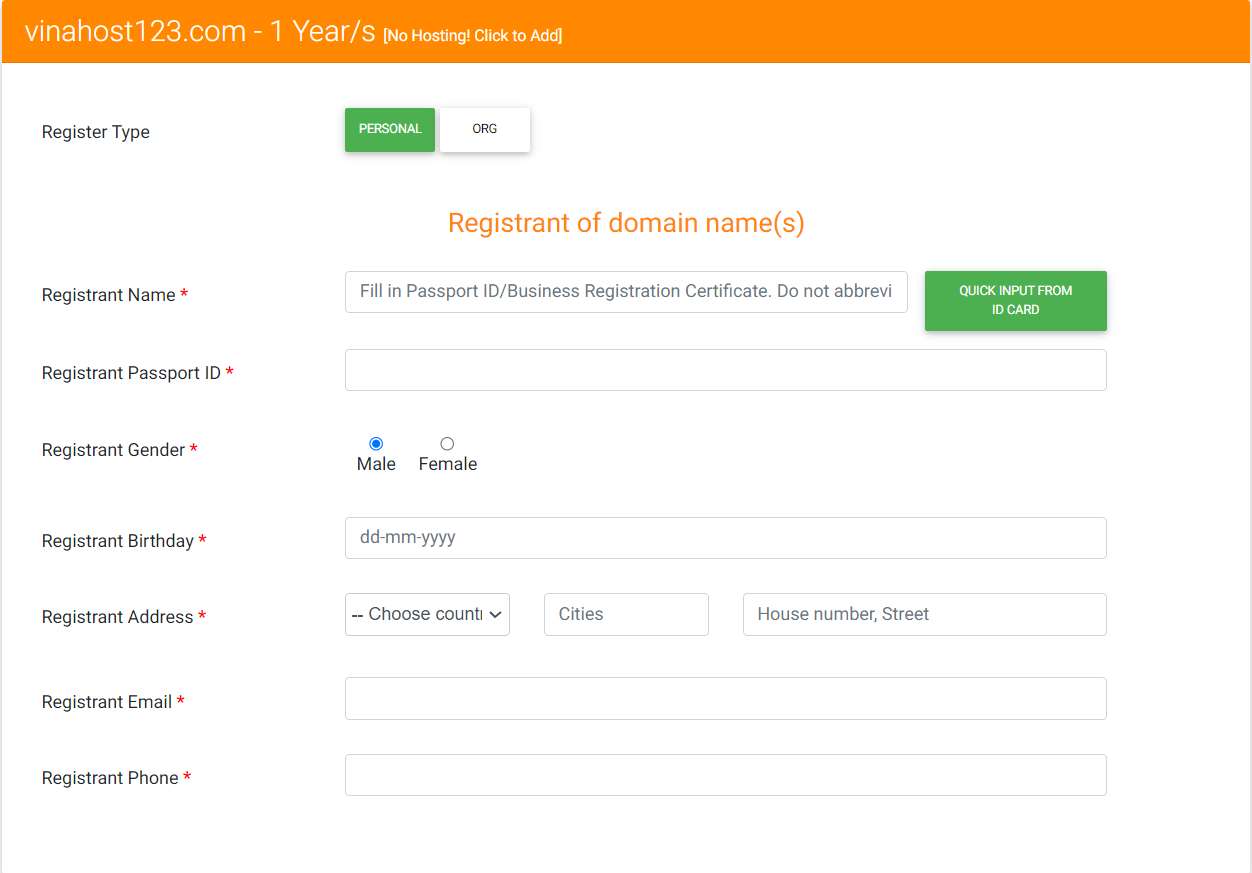
For organizations:
Select the registration type as Organization and fill in the following information:
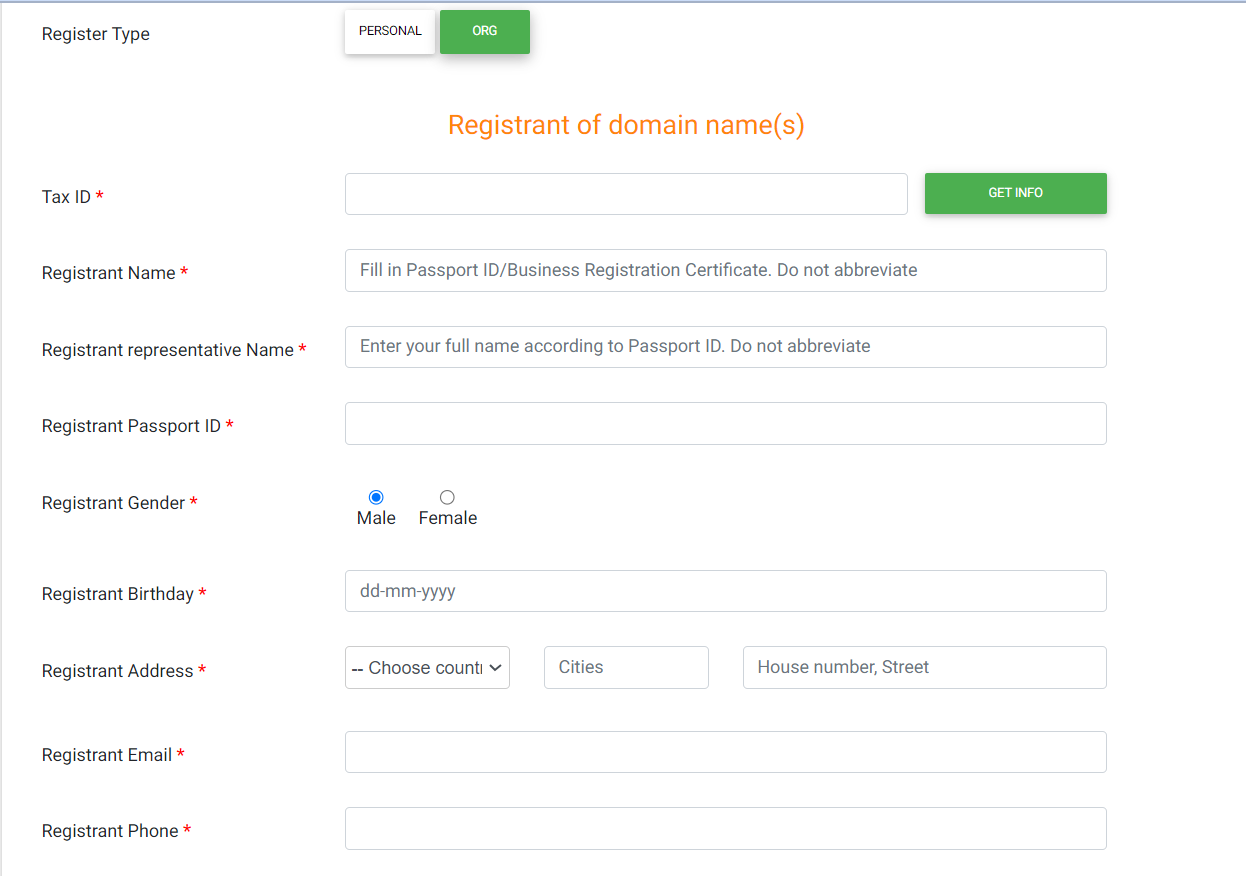
Enter other information: ID card/ Passport number of the representative, select gender, date of birth, phone number, and email.
Once all the information for the Domain Registration Entity is fully entered, the system will automatically fill in data for the Domain Manager and the Organization Representative during the domain registration procedure. You can also edit the information if necessary.
Step 3: Payment
Check the order information and enter a promotional code if you have.
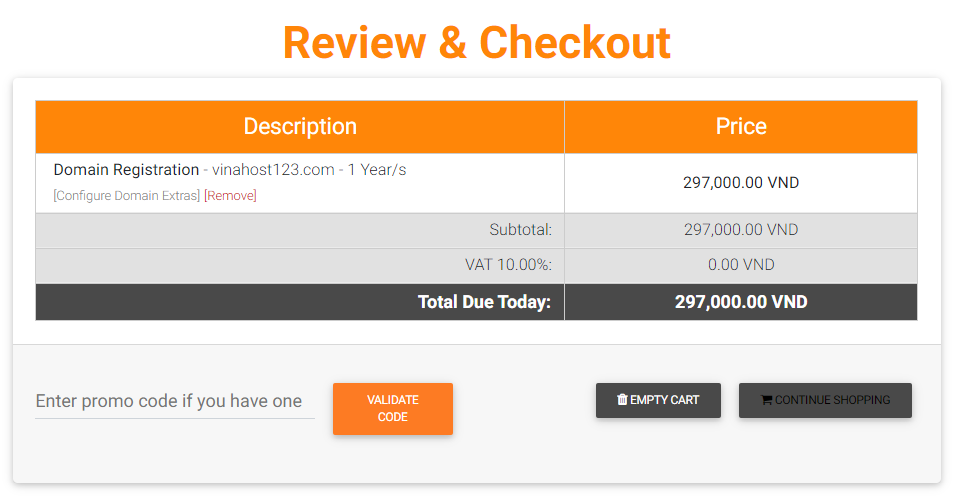
If this is your first time using the service and you do not have a registered account, VinaHost will ask you to provide information to create an account. Basic information includes: Full name, Email, Phone number, Address, Password, and a security question.
Enter information for invoice issuance, if needed.
Choose a suitable online payment method.
If desired, you can also choose to pay directly at the VinaHost Office at: Cuu Long Apartment, 351/31 No Trang Long, Ward 13, Binh Thanh District, Ho Chi Minh City (Gate B of Pham Van Dong street).
Step 4: Complete entity verification to use the domain name
Access the service management page on VinaHost: https://secure.vinahost.vn/ac/clientarea.php?language=english
In the main menu, select Verify Domain Owner. In the Entity Verification section, you will see a list of domain name profiles that need updating.
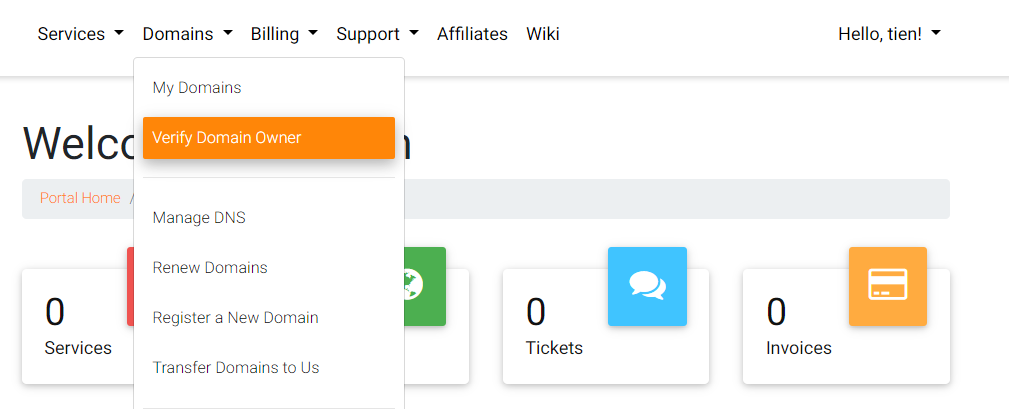
You can contact VinaHost’s customer care team for further guidance on adding information.
- Email: support@vinahost.vn
- Hotline: 1900 6046
- Livechat: https://livechat.vinahost.vn/chat.php
VinaHost will conduct checks and verify the domain name profile during administrative working hours.
7. The Future of .com Domains
Predicting the future of .com domains involves considering various factors, including technological advancements, market trends, regulatory changes, and consumer behavior. Here are some potential trajectories for the future of .com domains:
- Continued Dominance: .com domains have been the most popular and widely recognized domain extension for decades. Despite the introduction of numerous new domain extensions (.net, .org, .io, etc.), .com domains continue to dominate the market. It’s likely that .com will maintain its position as the preferred choice for businesses, organizations, and individuals due to its familiarity, credibility, and perceived trustworthiness.
- Increased Competition: While .com will likely remain dominant, there could be increased competition from alternative domain extensions. New generic top-level domains (gTLDs) introduced in recent years offer more specific and niche options (.tech, .store, .blog, etc.). These alternatives may appeal to businesses and individuals looking for creative or industry-specific domain names. However, .com’s strong brand recognition and established market presence will likely mitigate any significant erosion of its market share.
- Brand Protection: As the internet continues to grow and evolve, protecting brand identity and intellectual property becomes increasingly important. Companies may continue to prioritize securing .com domains to safeguard their brand names, trademarks, and online presence. This could lead to sustained demand for premium .com domains, driving up prices in the aftermarket.
- Regulatory Changes: Regulatory developments, such as changes in domain registration rules or the introduction of new policies by governing bodies like ICANN (Internet Corporation for Assigned Names and Numbers), could impact the landscape of .com domains. For example, changes in privacy regulations or data protection laws may influence domain registration practices, potentially affecting the availability or accessibility of .com domains.
- Technological Advancements: Emerging technologies like blockchain and decentralized domain systems have the potential to disrupt traditional domain registration and management processes. Decentralized domain platforms offer increased security, transparency, and ownership control over domain names. While these technologies are still in their early stages, they could introduce alternative methods for acquiring and managing domain names, potentially impacting the relevance of traditional domain extensions like .com.
Overall, while the future of .com domains may see some changes influenced by market dynamics, technological innovations, and regulatory factors, it’s likely that .com will remain the cornerstone of the internet’s addressing system for the foreseeable future. Its enduring popularity and widespread adoption make it a reliable choice for establishing an online presence.
8. FAQs
8.1. Is .com always the best choice for my domain name?
Choosing the right domain extension depends on various factors, including the purpose of your website, your target audience, and your branding strategy. While .com is the most popular and widely recognized domain extension, it may not always be the best choice for every situation. Here are some considerations:
- Availability: .com domains are highly sought after and may have limited availability, especially for common words or phrases. If your desired “.com” domain is already taken, you might consider alternative extensions.
- Purpose: If your website primarily targets a specific country or region, using a country code top-level domain (ccTLD) like “.uk” for the United Kingdom or “.de” for Germany can help localize your online presence and improve your website’s relevance to local users.
- Industry: Certain industries or communities have their own specialized domain extensions, such as “.edu” for educational institutions, “.org” for organizations, or “.gov” for government websites. Using these extensions can convey credibility and relevance within your industry.
- Brand Identity: Your domain name plays a crucial role in your brand identity. Choosing a domain extension that aligns with your brand and communicates your message effectively can enhance brand recognition and memorability.
- SEO Considerations: While there’s no direct evidence that “.com” domains have a significant advantage in search engine optimization (SEO) over other domain extensions, some studies suggest that users may perceive “.com” websites as more trustworthy. However, with proper SEO practices, you can achieve good search engine rankings regardless of your domain extension.
- Protecting Your Brand: Regardless of the primary domain extension you choose, it’s often a good idea to register other popular extensions (e.g., “.net”, “.org”) and common misspellings of your domain to prevent competitors or malicious actors from capitalizing on your brand name.
In conclusion, while .com is often considered the default choice for domain names, it’s not always the best fit for every situation. Consider your specific needs, target audience, and branding goals when choosing a domain extension. Ultimately, the most important factors are relevance, memorability, and consistency with your overall brand strategy.
8.2. What if the perfect .com domain name is already taken?
If the perfect .com domain name for your project or business is already taken, you have several avenues to explore. Here’s how you can approach this situation:
Choose a Different Domain Extension
If the .com version is taken, consider whether another top-level domain (TLD) might work just as well for your needs. For instance:
- .net or .org for organizations, especially if they’re tech-oriented or non-profit, respectively.
- A country-specific TLD (ccTLD) like .us (United States), .ca (Canada), or .uk (United Kingdom) if your business is focused on a particular geographic area.
- Industry-specific TLDs like .tech, .art, .finance, which can immediately communicate your field of expertise.
Modify the Domain Name
- Additions: Try adding relevant keywords or short phrases to your desired name without making it too lengthy or complicated. For example, if “BlueWidgets.com” is taken, consider “BuyBlueWidgets.com” or “BlueWidgetsOnline.com.”
- Prefixes/Suffixes: Use prefixes (e.g., The, My, Get) or suffixes (e.g., Shop, HQ, Co) to find an available variation that still communicates your brand effectively.
Contact the Current Owner
If you’re set on a specific .com domain, you can look into purchasing it from the current owner:
- Check the WHOIS database to find contact information for the owner. However, privacy settings may limit the available information.
- If the domain is parked or for sale, there might be contact information or a price listed directly on the website.
- Be prepared to negotiate. The asking price for domains can vary widely based on perceived value.
Consider a Backorder Service
If the domain is about to expire and you believe the current owner might not renew it, you can use a domain backorder service. These services attempt to register the domain on your behalf the moment it becomes available. Success isn’t guaranteed, especially for highly sought-after domains, as there may be competition.
Legal Action (Caution Advised)
If you believe you have a legitimate claim to the domain (e.g., it’s your trademarked brand name), you might consider legal channels. The Uniform Domain-Name Dispute-Resolution Policy (UDRP) provided by ICANN is one way to resolve domain disputes. However, this should be a last resort, as it can be costly and there’s no guarantee of success.
Strategic Considerations
Remember, the domain name is just one part of your overall brand and online presence. While important, it’s not the sole factor that determines the success of your website or business. Quality content, user experience, and effective marketing play significant roles as well.

8.3. Can I own multiple domain names with different extensions?
Yes, you can own multiple domain names with different extensions, and many businesses and individuals do this for various strategic reasons. Owning several domain variations can be beneficial in several ways:
Brand Protection
Registering your domain name with multiple top-level domains (TLDs) prevents others from acquiring those versions and potentially misusing them. This strategy protects your brand identity and reputation.
Market Expansion
If you’re planning to expand your business internationally, owning the country code top-level domain (ccTLD) for specific markets (like .uk, .ca, .de) can help tailor your presence to those regions. It signals to users and search engines alike that your site is relevant for that specific country.
SEO and User Experience
Having multiple domains can also be used to redirect users to the most relevant page, improving user experience and potentially aiding your SEO efforts. For example, you might have specific landing pages for different regions and use ccTLDs to direct users there.
Defensive Registration
To prevent cybersquatting, where individuals register domain names similar to a trademark or business with the intent to sell them at a premium, companies often purchase various domain extensions. This is a form of defensive registration to safeguard against potential abuse.
Promotional Strategies
Using different domains for specific campaigns or product launches can be an effective marketing strategy. This allows you to create targeted messaging and track the campaign’s performance more directly.
Managing Multiple Domains
While owning multiple domains can be advantageous, it also requires management to ensure that they’re used effectively:
- Renewals: Keep track of renewal dates to prevent losing ownership of your domains.
- Consistent Branding: Ensure that any redirects or use of multiple domains does not confuse your brand message.
- Search Engine Optimization: Be mindful of how you use redirects so as not to dilute your SEO efforts. Properly set up 301 redirects if you’re funneling traffic from multiple domains to a primary one.
- Legal Considerations: Ensure that your domain registrations do not infringe on someone else’s trademarks or brand names to avoid legal issues.
Owning multiple domains is a strategic decision that can enhance your online presence and protect your brand. However, it’s important to weigh the benefits against the cost and effort required to manage multiple domains effectively.
8.4. How much does it cost to register a .com domain?
The cost to register a .com domain can vary widely depending on several factors, including the registrar you choose, the uniqueness and desirability of the domain name, and any additional services you opt for during the registration process (like privacy protection, hosting services, or email accounts).
Base Registration Cost
- Standard .com Registration: On average, the base cost to register a .com domain is typically around $10 to $15 per year for a standard domain name. This is a rough estimate, and prices can be lower or higher based on the registrar and any promotions they might be running.
Additional Costs and Discounts
- Renewal Fees: The renewal cost is usually similar to the registration fee, but it’s always a good idea to check the renewal rates since some registrars offer a lower initial price and higher renewal rates.
- Privacy Protection: Many registrars offer WHOIS privacy protection (or a similar service) that hides your personal information from the public WHOIS database. This service can be free or might cost an additional $5 to $20 per year, depending on the registrar.
- Transfers and Additional Services: If you transfer your domain to another registrar or opt for additional services like web hosting or professional email, your costs will vary accordingly.
Choosing a Registrar
When choosing a registrar, consider the total cost of ownership, not just the initial registration fee. Look for hidden fees, the cost of add-ons, and the renewal rates. Some reputable registrars might offer packages or discounts that include domain registration as part of a web hosting plan, which might be worth considering if you’re starting a new website.
Tips for Saving Money
- Look for Promotions: Registrars often run promotions for new registrations. Be sure to search for coupons or deals before purchasing.
- Bundle Services: Sometimes, bundling services like domain registration, web hosting, and email hosting can save money.
- Consider Long-Term Registration: Registering your domain for multiple years upfront can sometimes offer savings over annual renewals.
Keep in mind that while the cost is an important factor, it’s also crucial to choose a reliable registrar that offers good customer support, has a user-friendly management interface, and maintains a solid reputation in the industry.
9. Conclusion
The domain name plays a crucial role in building and developing a brand over time. It directly affects the performance of the website. Therefore, you should carefully consider when choosing a domain name, especially a .com domain. This is the top choice that all businesses should consider.
We hope you understand what is domain .com. If you have any questions that need clarification, please don’t hesitate to contact us.
- Email: support@vinahost.vn
- Hotline: 1900 604
- Livechat: https://livechat.vinahost.vn/chat.php
You can also check out other interesting articles HERE to stay updated with new knowledge every day.
What is Addon Domain – A Gateway to Website Expansion
What is a Parked Domain: What You Need to Know
What is a Server? Understanding the Backbone of Modern Technology
What is VPS? | Unveiling the Power Behind Virtual Private Servers


 Tiếng Việt
Tiếng Việt English
English 简体中文
简体中文



















































































